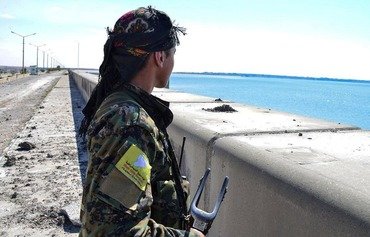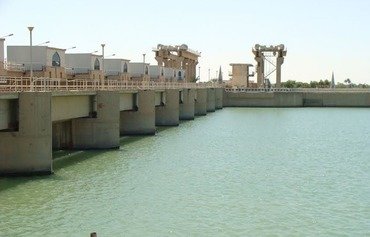Through its involvement in a massive project to stabilise the Mosul Dam, the US Army Corps of Engineers (USACE) has contributed to the safety of the structure and to improving water security for the people of Iraq, Iraqi officials said.
Since it entered operation in 1986, the Mosul Dam has required special maintenance, as it is built on geology that contains gypsum, which is soluble in water and can easily erode.
This was carried out by the Iraqi Ministry of Water Resources in partnership with an international consortium, but unstable security and an "Islamic State of Iraq and Syria" (ISIS) attack in August 2014 disrupted maintenance operations.
For around six weeks -- until Iraqi forces retook the dam from ISIS with international coalition backing -- no maintenance work was done.
![Iraqi engineers stand inside a cement injection unit beneath Mosul Dam on April 21st. [Photo courtesy of the Iraqi Ministry of Water Resources]](/cnmi_di/images/2019/06/19/18539-Mosul-dam-engineers-600_384.jpg)
Iraqi engineers stand inside a cement injection unit beneath Mosul Dam on April 21st. [Photo courtesy of the Iraqi Ministry of Water Resources]
Amid international concern about the increased potential for a breach, the Iraqi government asked USACE for help.
In March 2016, the Iraqi government signed a $296 million emergency maintenance contract with the Trevi Group, an Italian engineering firm, with the contract to be administered by USACE.
USACE put together a team of US military personnel, US government experts and private technical contractors to supervise Trevi Group as it carried out the emergency grouting work, with the goal of stabilizing the dam.
USACE, in turn, hired multinational engineering firm AECOM to provide field support. With the addition of AECOM, a total of around 70 international engineers were on site to assist with the project.
Extensive training
Since the Trevi Group began its work, Iraqi staff and engineers have received extensive training on the use of highly advanced equipment and technologies at a school created on site, the engineering firm said.
This has included instruction on how to perform the maintenance grouting and rehabilitation of the bottom outlet tunnels beneath the Mosul Dam.
USACE also has offered Iraqi personnel training in order to develop their technical capabilities and enable them to lead the maintenance and operation of the dam themselves.
Because of the unstable nature of the ground on which Mosul Dam was built, maintenance operations require that cement be injected deep into the ground beneath the dam's foundation to create a barrier against water erosion.
According to a 2007 report, approximately 200 tonnes of cement per year are required to ensure the dam can withstand the pressure of the water it contains behind it.
"National personnel have acquired good skills and experience in the operation of modern equipment and devices developed for cement filling for the dam's body and in the monitoring of its performance and water reserves," said Adil al-Mukhtar, an adviser to the Iraqi parliament’s agriculture and water committee.
"Our engineers, thanks to the international expertise they have acquired, have become more effective and better ready to carry out all work required to effectively maintain and run the dam," he told Diyaruna.
After the fears of the ISIS era and the resulting disruption of maintenance activity, the dam is now in a "very safe state", al-Mukhtar said.
"Maintenance and [cement] injection work goes on around the clock, and the flow and exit of stored water through the main gates are occurring smoothly," he said.
"The dam is functioning normally and has showed high effectiveness in absorbing floodwaters during the last winter season as result of the rehabilitation procedures that have been carried out," he added.
Dam is working well
The Mosul Dam is "at this point working at its best", Iraqi Water Resources Minister Jamal al-Adli said during a May 29th visit to the facility.
The dam’s foundations are today planted in a "mountain of cement", he said, during a joint meeting with representatives of the Trevi Group and USACE to discuss the handing over of maintenance tasks.
The dam currently has water reserves of "more than eight billion cubic metres", dams and water policies expert Ramadan Hamza told Diyaruna.
"The water level in the dam reservoir has reached 325 meters above sea level, an exceptional rise that has not been seen for many years, thanks to the heavy rains," he said.
"The rains have strengthened Iraq’s water situation, and government efforts are being made to meet farmers' needs for water" and combat desertification, he said.
He expressed confidence in the ability of Iraqi personnel to pick up from the Italian and US experts and run Mosul Dam's maintenance and operations.
Improving water infrastructure
The Iraqi government is working to improve the country's water infrastructure.
In addition to the Mosul Dam, it is preparing to rebuild the Badush Dam in Ninawa province, which ceased operation decades ago.
The Ministry of Water Resources on May 18th began preparing technical studies in preparation for the project.
The Bakhma Dam in Erbil is also slated for work, to support the irrigation of more than 560 hectares of farmland and the production of 1,500 megawatts of electricity.
Iraq also is planning to rehabilitate 30 small dams on the border with Iran to control and take advantage of the floodwater coming from the Iranian highlands.
Iraq needs "about five new giant dams to store every drop of water flowing to the country through regional rivers or rainwater", Hamza said.
"A contingency plan must be put in place and sufficient funds allocated for projects to avoid impact of droughts that may be more severe than previous ones," he said.
Meanwhile, Ninawa provincial council's planning committee is preparing to ask the federal government to build secondary dams in the province, committee chairman Khalaf al-Hadidi told Diyaruna.
"Studies and proposals have been developed to exploit the abundant amounts of rainwater by building small dam projects in wadis and channelling their water reserves towards the huge farming lands in the province," he said.
"Ninawa is Iraq’s breadbasket, and the construction of dams in the province will support food security in the country and strengthen the national economy and the pace of development," he added.
Water is an invaluable resource "and we aim to develop it as required", he said.

![Mosul Dam is seen here in a photo posted online on April 15th. [Photo courtesy of the Iraqi Ministry of Water Resources]](/cnmi_di/images/2019/06/19/18538-Iraq-Mosul-dam-600_384.jpg)





